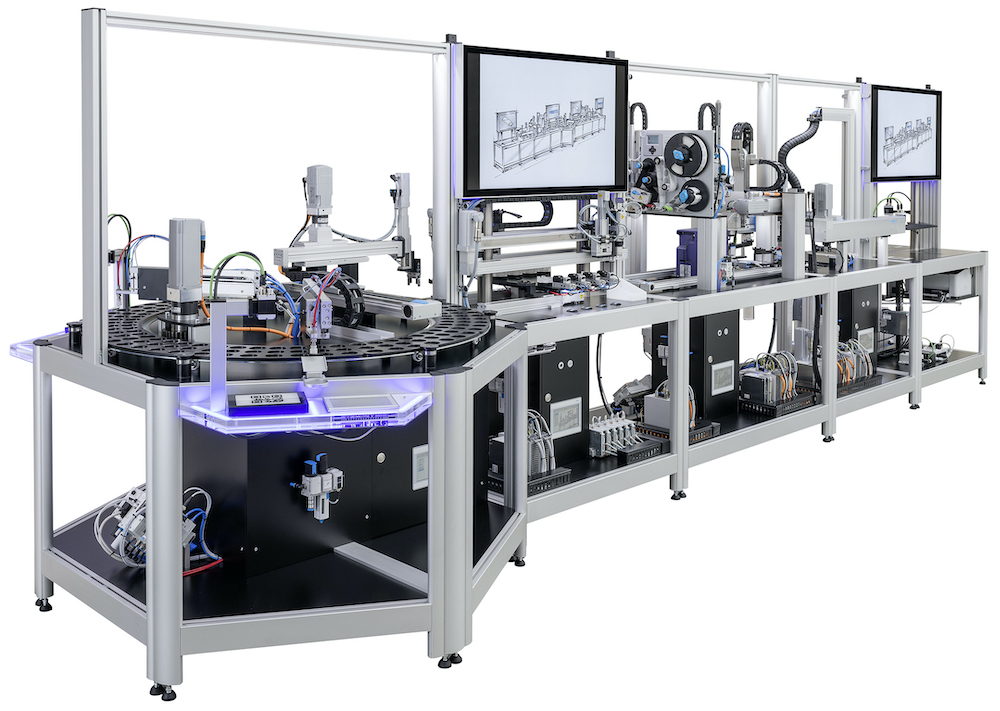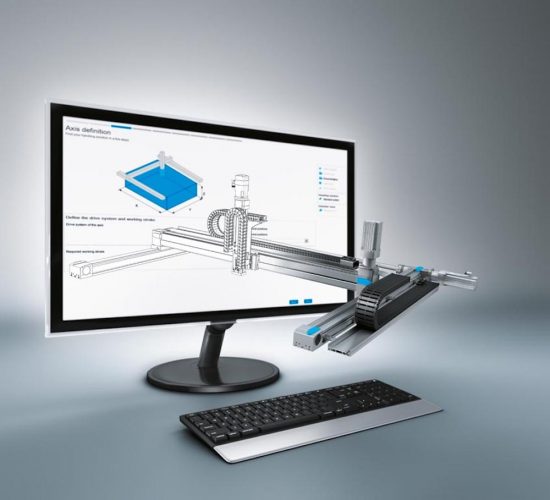
Festo combines mass production, customization in demo automation system
February 3, 2021
By Manufacturing AUTOMATION
 The Productivity Master, a modular demonstration system from Festo shows how automation technology will evolve along the value chain when combined with digitalization. Photo: Festo
The Productivity Master, a modular demonstration system from Festo shows how automation technology will evolve along the value chain when combined with digitalization. Photo: Festo Festo has unveiled a modular demo system that combines both mass production and individualization of finished products.
The automation company showed the Productivity Master solution at a Feb. 3 preview for the Hannover Messe technology conference, which takes place online Apr. 12 to 16.
This Industry 4.0 platform shows how automation technology can be used along the value chain when combined with digitalization.
The Productivity Master is an integrated system that links the company’s engineering tools, components and solutions in hardware and software. The electrical products, the axis mechanics, the electrics and the software are planned as a complete automation platform enabled with connectivity.
Data in the cloud
At the preview, the Productivity Master was set up to produce personalized USB memory sticks.
The system uses a cloud-based concept for registering and storing customer data complying with data protection regulations. This allows USB sticks to be produced with a personalized design as well as personalized data content. Customers can upload their personalization preferences from home via the Internet without having to enter further data from any parties on the supplier side.
Festo’s IoT gateway securely connects the machine to the cloud so that operators can retrieve production data from the cloud and have onsite or remote access to the machine’s diagnostic data.
Four fully connected stations
Customers create the production order at the first station by registering with their name and perhaps a picture. A QR code identifies the visitors at the machine. A vision sensor SBSI from Festo registers the visitors and starts the production order. This is followed by stock management.
This is a complete mechatronic solution, with a planar surface gantry EXCM in size 40 for fast picking and placing of the USB memory stick. The USB memory stick is then transported, printed, turned over and then passed on.
The work steps at the second station are holding, moving, handling, rotating and positioning, and identifying the workpiece position, as well as identifying, separating, gripping and applying labels. Fast transfer to a label printer is carried out at station three by a dynamic linear gantry EXCT with dynamic servo motors EMMT-AS and servo drives CMMT-AS. The rotation functions are carried out by electric rotary drives ERMH.
The process is completed in station four, where files are uploaded to the USB memory stick. This involves holding the workpiece, turning and carefully positioning the cap and press-fitting delicate parts. This is done using the electric cylinders EPCO and rotary drives ERMO. The personalized USB memory sticks can then be distributed.

Machine and equipment manufacturers can use the Handling Guide Online to select their solutions. Photo: Festo
Total connectivity
By leveraging industry-standard networks such as EtherCAT, OPC-UA, IO Link and MQTT, Festo can create a seamless data stream from individual sensors to remote IO, servo drives, controllers and the cloud.
This technology-neutral approach has a major impact on energy efficiency and sustainability. We call this ‘seamless connectivity,'” says Nigel Dawson, head of business development, electric automation at Festo, in a statement.
The machine was designed in record time. Festo’s unified engineering environment combining project planning and management of digital twins allowed designers and developers to work collaboratively worldwide.
With the Festo Handling Guide Online, users select and dimension 2D or 3D gantries in three steps. Programming, configuration and commissioning in a shared virtual environment is done through the Festo Automation Suite.
Pandemic showed need
The COVID-19 pandemic also showed the need for mass production and individualization or small-series production, the company says, particularly when it comes to mask production and vaccine research. The latter is more focused on precise data collection.
For mass production, however, it is crucial to be able to use remote diagnostics and maintenance tools to maintain machine uptime as long as possible while protecting operator health. These are just about ideal conditions for cloud-based diagnostic tools.
While the Productivity Master features a mix of pneumatic and electric automation, from flow sensors to servo drives, from pneumatic slide units to electric Cartesian robots, it is the way these products are connected that enables true digitalization.
Advertisement
- Canada signs deal with Novavax to make COVID-19 vaccine in Montreal
- The February issue of Manufacturing AUTOMATION is online!